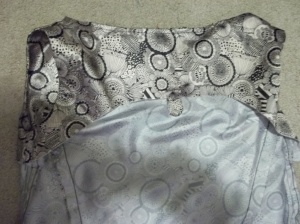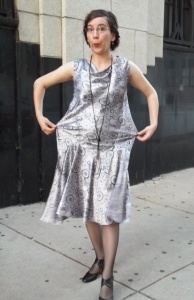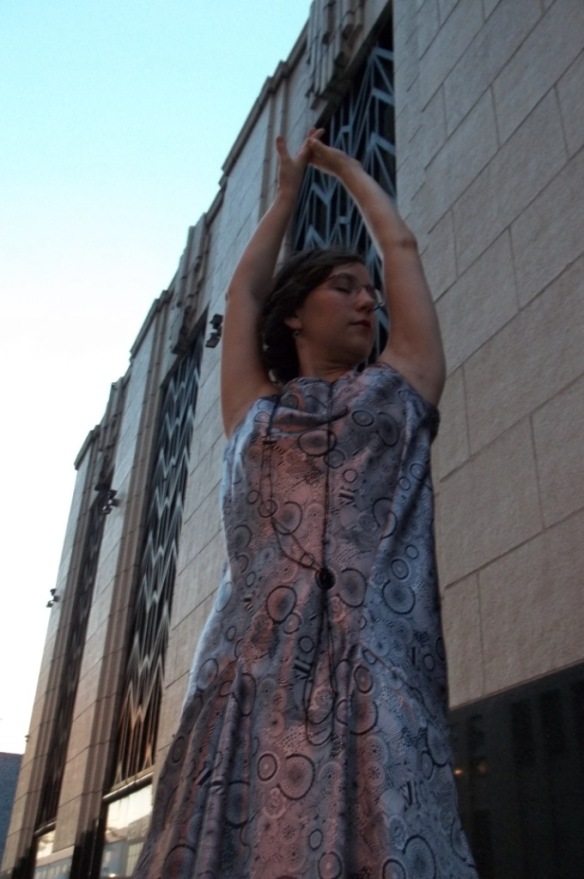In strong simulation of the famous Madeleine Vionnet, this Burda Style dress is perfect for modern day glamour a la 1920’s. My fabric is a silvery pink satin. With its frosty sheen and surrealist clock “cog works” print, the fabric reminds me specifically of the cold, hard, mathematical beauty that I love about the Art Deco era. The dress, in classic Vionnet style, is on the bias for a flowing, body complimentary gown the likes of which are not seen that often in modern patterns anymore. I love this dress!
 I am not exaggerating – this is one of the most ingenious designs I have come across in my sewing. It’s so simple yet so complex and so smart. Just a few geometric shapes cut in the right grain line makes all the difference. Vionnet had the foresight and ingenuity to create very similar styles, but Burda made this kind of dress reasonable in price and availability as a great option to going with a pricey hard-to-find old 1930’s/1920’s original patterns (at left)…without compromising authenticity. Yes, believe it or not the 1920’s was more than just beads and fringe – it was also about bias cuts, freedom to move unconfined, and mathematical glamor.
I am not exaggerating – this is one of the most ingenious designs I have come across in my sewing. It’s so simple yet so complex and so smart. Just a few geometric shapes cut in the right grain line makes all the difference. Vionnet had the foresight and ingenuity to create very similar styles, but Burda made this kind of dress reasonable in price and availability as a great option to going with a pricey hard-to-find old 1930’s/1920’s original patterns (at left)…without compromising authenticity. Yes, believe it or not the 1920’s was more than just beads and fringe – it was also about bias cuts, freedom to move unconfined, and mathematical glamor.
FABRIC: A 100% polyester satin bought from a Hancock Fabrics store
PATTERN: Cowl Neck Dress #102, from 07/2012, on Burda Style’s store online or in the July monthly magazine issue.
NOTIONS: I had the interfacing and thread I needed, as well as the money coins which went into the fabric weights for the dress’ inside.
THE INSIDES: As this is on the bias, all seams are left raw and free.
 TIME TO COMPLETE: This was made quickly in about 6 hours, and finished on August 8, 2014.
TIME TO COMPLETE: This was made quickly in about 6 hours, and finished on August 8, 2014.
TOTAL COST: about $10
This was my first Burda Pattern to make and I’m glad it was a success. The instructions for the neck/bodice all-in-one facing were quite impossible to understand merely reading but as long as I followed them to the letter in my sewing, as weird as they sounded all worked out great. I didn’t do any changes to the pattern. Besides fitting in the sides, I kept the proportions and length as-is.
As for any Burda Style pattern, printing and/or tracing is necessary to have a usable pattern to lay on your desired fabric. My pattern was traced out using a roll of medical paper from the insert sheet of the magazine issue but you can also buy it, download it, and print it out from Burda Style’s online store. It’s at this preliminary step that you pick out your proper size and add in your choice of seam allowance width. A scissor with a magnetic ruler guide helps immensely to quicken along the step to getting a finished pattern prepped. Sorry to repeat something you might already know, but this is just an “FYI” for those that don’t know.
Usually I grade from my “normal” Burda size (usually the smallest one offered) up to the next size for the hips but for this pattern I made the whole dress out of the size for my hips, just to be on the safe side. However, I ended up taking in each side a few inches. I don’t know if the bias is making the dress size seem so big or if it’s truly the sizing but either way for more of a body fit, rather than a loose and overall drapey fit, go a size down. Now that I’ve made a few bias garments I’ve found there is a delicate balance. A loose fit is needed so the bias does hang a bit on the body (you don’t want the bias stretched over you) but yet too much ease can make bias dresses look bad and frumpy with draping and wrinkles in the wrong places. 
The vertical sides of the dress are on the bias, but the side panels take turns with the main body of the dress to change things up. There is the straight grain on the semi-horizontal downward edges of the panels while those corresponding seams of the dress are on the bias. I had to be careful of both differing grains to ease in the fullness and yet also not stretch the bias in those spots– slightly tricky.
Bias cut also means no closures, no darts – just simple beauty. Sweet!!! While on me, if I pinch the dress and pull it out it could just keep going. When putting this on, it falls open wide so it seems like a giant dress but then once it comes on over the head it magically falls around my body to fit. Bias cut is so awesome yet so sadly unknown by the general non-sewing populace (at least from my experience).
My chosen fabric is feather-weight so it really makes the dress flow nicely, but with a slightly heavier fabric (such as a rayon crepe or silk charmeuse) the dress would have more of a correct drape. Thus, I had to add some strategic weights at certain spots of the dress. The cowl needed to drape better to keep the neckline down so I added a weight to the inside of the center front. Then, the dress was lopsided so I had to also add a matching weight to the inside center back neckline. My weights are merely small rectangular “pockets”, made from the same fabric as the dress, and they hold two quarters each. So, I guess I ended up putting and extra dollar into my dress just to keep it hanging right on me! Whatever it takes…
I really don’t know why but the high-low hem didn’t turn out as obvious as in the pattern’s line drawing. The high-low hem was a trademark of the late 1920’s and very early 30’s, which is why this dress is part of my “Retro Forward” blog series. Around the time of the stock market crash of 1929, hemlines became more modestly transitional to the mid-calf skirt/dress lengths of the 1930’s by being frequently part short (like the 1920’s) yet getting elongated (mostly visually) by also being partially long. Thus, during the transition of the 30’s and 20’s all sorts of hemlines became popular such as “high-low” hems, “hankie” hems (see this post), fur trimmed hems – and the variety doesn’t end there! I find it funny how I still see many of these hemline styles in modern clothes. Also, this Burda pattern is totally a Tango dress…similar to Folkwear’s version. Many varied length hemlines were seen on dresses styled with a Spanish influence to be worn swaying to the then “new” music craze of the Tango. Dancing that required full movement of the body was then not only popular but actually possible, too, for corset-less unconfined women in the late 1920’s, and crazy hemlines with body hugging bias cuts made the dancer seem all the more exotic.
This dress can easily go modern, but I preferred to glam it up ‘a la’ late 20’s style, with my fishnet stockings, bobbed hair, and my handmade long beaded necklace. My Tango-style shoes are (I think) “1960’s does 1920’s” – they are “Debs” made by the famous Palter DeLiso footwear designer.
Even our background has the same time period and the same geometric shapes as my dress. The building behind me is one which I have long admired and I happy to be integrating it into a project’s photo shoot. It was built in 1930 as a power-station for an electric company, it is so awesome for such a mundane use, but that is the Art Deco movement to put glamour in everyday life. The National Register of Historic Places Inventory for this building (page 16) lists it as “having metal grillwork in an abstract chevron-like pattern fills the rectangular openings” between the terra cotta and marble of the piers on the building. “Above the openings of the spandrels, between the piers, large stylized ornament, linear, with hard edges, embellishes the parapets.” Aren’t those details amazing?! Sorry to go into detail here but I love historic architecture appreciation, and this building is up there on my “favorites” list so I can easily get going!
I hope you like Art Deco like I do and hopefully this post can inspire you look for this era’s buildings in your town or even to work a little of this era into your sewing. Have you tried bias garments, especially these geometric 20’s and 30’s ones with beautiful simple design like this dress? If you have, they’re special aren’t they?! If not, you need to go ahead and make one…let me know about it…I’d like to see it!








I love your dress. Bias cut dresses are so glamorous and flattering. I love the fabric you chose for it as well. I love art deco fashion and architecture. We don’t have much in Vancouver as its a young city but my grandmother grew up in an art deco neighborhood in Amsterdam. Its funny because at the time it was considered less classy than living in the older neighborhood because it was all trendy “new money” but when I visited it looked so beautiful to me. Funny how these things change.
I have seen you mention scissors with a magnet attachment before but I’m having trouble imagining them as I haven’t seen them. Can you like to some?
Enjoyed reading your blog as always.
LikeLike
Renee, Thank you for the compliments, but especially for sharing Art Deco love with me! That’s interesting about Amsterdam, does it have have a cultural influence to it’s Art Deco? I have read up on and admired pictures of an Art Deco neighborhood in India and the cultural influence to its designs are stunning. I think I understand about the view point of the trendy versus “old money” – kind of like in “The Great Gatsby” book?
Our town is going through a phase where the beautiful old buildings are condemned as not “up to modern standards” and torn down thoughtlessly for non-generic structures – so frustrating! Those buildings are an irreplaceable part of history even if not everyone sees it…
As for the scissors and magnet attachment for Burda patterns, great question! You can buy an small ribbed knob online (link here to one seller) which sticks onto the side of your scissors to give an automatic seam allowance as you cut. But – I use an inexpensive option where I have one of those magnetic seam allowance sewing machine guides (about a small flat square) and the magnet underneath sticks it to the top edge of my scissors. I have different seam allowances drawn on the guide with a marker. You can see a picture of what I do in my post about my “Spicy Stripes” dress. Let me know if this helps and if I explained it o.k.
LikeLike
Sorry for the long delay in reply. I had a baby and it’s really thrown my sewing/blogging life to the side for now.
I wish I could tell you what the cultural influence of Amsterdam was but I don’t know. My family weren’t particularly interested, they left because they wanted the wilderness of BC and to escape city life. I think it’s all so beautiful though.
I’m sorry to hear about your town losing it’s historical character. I will reference my limited knowledge of Amsterdam again, as they seem to take their old buildings and gut them and renovate them so the exterior looks renewed and just as it did hundreds of years ago while the inside looks like an apartment out of an Ikea catalogue. It’s quite surreal to me as I live in Vancouver, BC, a relatively new city with very few older buildings. Here, downtown is all glass skyscrapers set to a back drop of ocean and mountains. It’s breathtaking in it’s own right but in a very different way.
Thanks for the link the magnet seam allowance. It’s quite clever. I think I can rig something up like you did for less than the cost of it plus shipping.
I always enjoy reading your blog. Late at night when I’m up with my daughter I read sewing blogs and I always learn something from yours. Just know it’s appreciated, even if comments are few and far between.
LikeLike
This looks amazing on you, such a beautiful fabric and pattern. The shoes are a dream, also 🙂
LikeLike
Thanks! You’re so kind. This dress was tricky to catch on camera – the sun was going down and the wind was against me but I’m glad you like it.
Would you guess my shoes are quite interesting to put on…wrap around straps with triple buckles on each shoe makes them something to take into consideration when trying to get ready to go out! So comfy, though.
LikeLike
I have been searching for the right fabric for a bias garment. Your’s is so elegant. I only hope I find something as nice!
LikeLike
Linda, thank you for your comment and compliment! Oh, I’m sure you’ll find the right fabric to make a great bias garment, but yes, it does take some looking. For bias projects, I like lightweight fabric which is just heavy enough to shift the bias/grain line when let to hang (hope that makes sense). A tip for a polyester fabric – I did have major static cling issues with this dress, but wearing my rayon challis slip underneath got rid of that.
LikeLiked by 1 person
Thanks for the extra information! I’ll keep that in mind.
LikeLike
Pingback: “Minted Lime” Midi Flapper Dress | Seam Racer